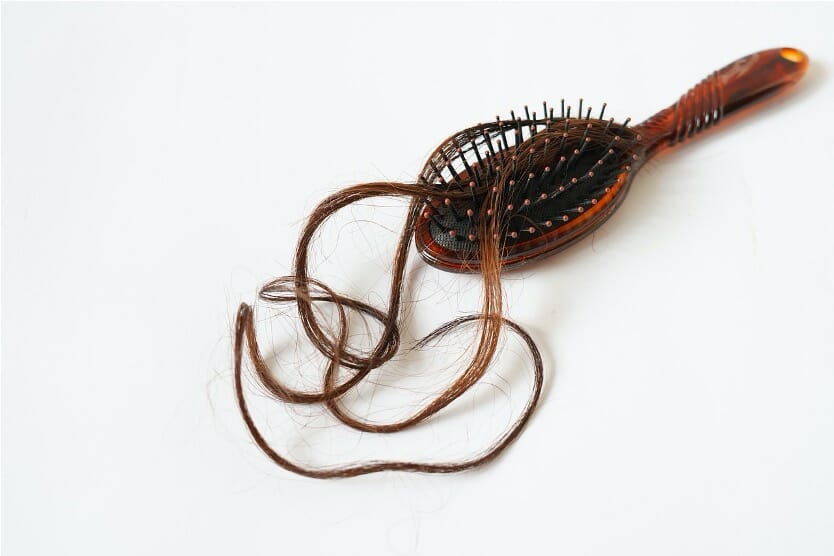Quick Summary: How Much Hair Loss Per Day is Normal for a Male?
- Normal Hair Loss: It’s normal to shed 50-100 hairs daily, a natural part of the hair growth cycle. The hair growth cycle can be divided into three stages: anagen, catagen, and telogen phases.
- Excessive Hair Loss: Noticeably more hair loss can be a sign of underlying health issues. Genetics, aging, medical conditions, medications, stress, and diet can contribute to hair loss.
- Solutions to reduce hair loss: Maintaining a healthy lifestyle, using gentle hair care products, and exploring medical treatments can help manage hair loss.
- Hair transplants, the Permanent Solution to Hair Loss: Hair transplant surgery offer a long-lasting solution to male hair loss by relocating healthy hair follicles from a donor area to thinning or bald spots. This surgical approach provides natural-looking results, helping men regain both their hair and confidence.
Hair loss is a common concern for men, and it can be a source of anxiety and embarrassment. But how much hair loss is normal? And when should you start to worry? In this blog post, we will explore the hair growth cycle, how much hair loss is normal for men, and the factors that can affect hair loss. We will also provide some tips on how to reduce hair loss and when to consult a doctor.
Hair Growth Stages
Hair growth is a complex biological process that can be divided into three distinct stages: anagen, catagen, and telogen1. Understanding these phases is essential for comprehending the normal cycle of hair growth and the factors that can influence it.
Anagen: The Growth Phase
The anagen phase is the most active stage of hair growth. During this period, the hair follicle undergoes a series of complex biological processes, including proliferation and differentiation of hair progenitor cells. This ultimately leads to the formation of a new hair shaft, which emerges from the skin’s surface. The anagen phase can be further divided into two sub-phases:
- Proanagen: In this initial phase, the hair follicle begins to proliferate and differentiate hair progenitor cells.
- Metanagen: The new hair shaft becomes visible on the skin’s surface, marking the beginning of the metanagen phase.
Catagen: The Transitional Phase
The catagen phase represents the transitional stage between the active growth phase (anagen) and the resting phase (telogen) of the hair cycle. Lasting approximately two to four weeks, this stage involves the detachment of the hair follicle from the papilla, a structure that provides nourishment to the hair roots2. This detachment triggers cell death at the base of the follicle, leading to a reduction in hair diameter and the formation of a club hair, a non-growing hair strand3.
If a large number of hairs enter the catagen phase simultaneously and are subsequently shed, it can give the appearance of thinning hair. This can occur in various conditions, including hypothyroidism, hyperthyroidism, stress, vitamin deficiencies, and postpartum hair loss.
Telogen: The Resting Phase
The telogen phase is the final stage of the hair growth cycle. During this period, the hair follicle is dormant, and no further hair growth occurs. Approximately 10-15% of all hairs on the body are in the telogen phase at any given time2. The duration of the telogen phase can vary depending on the location of the hair, ranging from a few weeks for eyelashes to nearly a year for scalp hair.
The exact mechanisms that regulate the transition from one phase to the next are not fully understood. However, it is clear that a complex interplay of hormonal, genetic, and environmental factors influences the hair growth cycle.
How Much Hair Loss is Normal for Men?
According to the NHS, it is normal to lose 50-100 hairs per day4. However, this number can vary depending on your age, genetics, and overall health. Some men may start to lose hair as early as their teens or twenties, while others may not experience significant hair loss until later in life.
Here are some signs that you may be losing more hair than is normal:
- You are noticing more hair in the shower drain or on your brush.
- Your hairline is receding.
- You are developing bald spots.
However, you might notice more hair loss than usual when bathing or brushing your hair. This often happens because some hair strands, already shed from the scalp, can become tangled with the remaining hair. These loose hairs only fully detach during a thorough brushing or washing, making it seem like there’s more hair falling out at once. Therefore, seeing an increased amount of hair in your brush or drain doesn’t necessarily indicate excessive hair loss; it may simply be the accumulation of normal daily shedding that wasn’t immediately apparent.
Factors Affecting Hair Loss
There are a number of factors that can contribute to hair loss in men, including:
- Genetics: Male pattern baldness, also known as androgenetic alopecia, is the most common cause of hair loss in men. It is caused by a combination of genetics and male hormones.
- Age: As men age, they tend to produce less testosterone and more dihydrotestosterone (DHT). DHT is a hormone that can shrink hair follicles and shorten the growth phase of hair.
- Medical conditions: Certain medical conditions, such as thyroid disease, anaemia, and lupus, can cause hair loss.
- Medications: Some medications, such as chemotherapy drugs and blood thinners, can cause hair loss as a side effect.
- Stress: Severe stress can trigger hair loss, a condition known as telogen effluvium.
- Diet: A diet that is low in protein and essential nutrients can contribute to hair loss.
Tips to Reduce Hair Loss
There are a number of things you can do to reduce hair loss, including:
- Maintain a healthy lifestyle: Eat a healthy diet, get regular exercise, and manage stress.
- Use a gentle shampoo and conditioner: Avoid harsh shampoos that can strip your scalp of its natural oils.
- Be gentle with your hair: Avoid tight hairstyles and hairstyles that pull on your hair, as it can cause traction alopecia.
- Explore hair loss treatments: There are a number of hair loss treatments available, such as minoxidil and finasteride. These medications can help to slow hair loss and promote hair growth.
How do hair transplants help with hair loss?
Hair transplants are a popular and effective solution for men experiencing hair loss. The procedure involves relocating healthy hair follicles from a donor area, typically the back or sides of the scalp, to thinning or balding areas. This surgical intervention can provide natural-looking and long-lasting results, making it a preferred option for men suffering from male pattern baldness or other forms of hair loss.
There are two main techniques: Follicular Unit Transplantation (FUT) and Follicular Unit Extraction (FUE). Both methods have high success rates, with FUE being particularly popular due to its minimal scarring and quicker recovery time. Hair transplants can significantly restore not only hair density but also confidence and self-esteem for those affected by hair loss5. However, it is crucial to consult with a qualified surgeon to determine the most suitable approach based on individual hair loss patterns and expectations.
When to Consult a Doctor
While it’s normal to shed some hair daily, excessive hair loss can be a sign of underlying health issues. If you notice a sudden increase in hair shedding, patchy bald spots, or hair loss accompanied by other symptoms, it’s advisable to consult a doctor. Early diagnosis and treatment can help prevent further hair loss and address any underlying medical conditions. If you would like a health check for your hair or to visit our award winning hair transplant clinic, book a consultation with The Treatment Rooms, London today.
Conclusion
Hair loss is a common concern for men, but it is not something that you have to live with. While it’s normal to lose a certain amount of hair each day, excessive hair loss can be a sign of underlying health issues. There are a number of things you can do to reduce hair loss and keep your hair healthy. If you are concerned about hair loss, see a doctor to discuss your treatment options.
References
- Lin, X., Zhu, L. and He, J. (2022) ‘Morphogenesis, growth cycle and molecular regulation of hair follicles’, Frontiers in Cell and Developmental Biology, 10. Available at: https://www.ncbi.nlm.nih.gov/pmc/articles/PMC9133560/.
- Natarelli, N., Gahoonia, N. and Sivamani, R.K. (2023) ‘Integrative and mechanistic approach to the hair growth cycle and hair loss’, Journal of Clinical Medicine, 12(3), p. 893. Available at: https://www.mdpi.com/2077-0383/12/3/893.
- Hoover, E. (2023) Physiology, Hair, StatPearls [Internet]. Available at: https://www.ncbi.nlm.nih.gov/books/NBK499948/.
- Hair Loss (no date) NHS choices. Available at: https://www.nhs.uk/conditions/hair-loss/.
- Rassman, W.R. et al. (2002) ‘Follicular unit extraction: Minimally invasive surgery for hair transplantation’, Dermatologic Surgery, 28(8), pp. 720–728. Available at: https://pubmed.ncbi.nlm.nih.gov/12174065/
Share:
Authored by
Reviewed by
Book a Consultation
Related Blogs
Folic Acid and Hair Loss
March 12, 2025
Quick Summary Hair loss is a widespread concern that affects millions of people globally. While genetics, hormonal…
Andros Townsend Transplant: Before, After, and His New Hairline
March 11, 2025
He’s best known for his days spent kicking a ball around, but Premier League footballer Andros Townsend…
Harry Kane Hair and Hairline
March 11, 2025
Harry Kane has suffered from a common condition of hair loss called male pattern baldness. This has…
Joe Swash Transplant: Before, After, and His New Hairline
March 11, 2025
Former ‘EastEnders’ actor and ‘I’m a Celebrity’ contestant Joe Swash has spoken very candidly about receiving multiple…
Guide To Finasteride For Hair Loss
March 4, 2025
One of the main effective medications in treating hair loss is Finasteride, which is often prescribed to…
When Can You Safely Wear a Beanie After a Hair Transplant?
March 1, 2025
Quick Summary Cap Recommendations: Light, breathable caps like snapbacks or trucker’s caps are advisable if you need…
Dutasteride and Hair Loss
February 23, 2025
Dutasteride is a medication that can be prescribed to men suffering from male pattern hair loss (androgenic…
Receding Hairline In Women – What You Need To Know
February 20, 2025
Quick Summary What is a Receding Hairline? In women, a receding hairline is often more subtle than…
Norwood 2 Hair Loss And Hair Transplants
February 20, 2025
Norwood 2 is a specific stage of hair loss that forms part of the Norwood Scale. During…










